

Contributing — scikit-learn 0.21.3 documentation. This project is a community effort, and everyone is welcome to contribute.
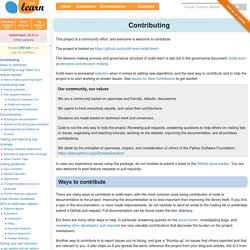
The project is hosted on The decision making process and governance structure of scikit-learn is laid out in the governance document: Scikit-learn governance and decision-making. Scikit-learn is somewhat selective when it comes to adding new algorithms, and the best way to contribute and to help the project is to start working on known issues. See Issues for New Contributors to get started. Our community, our values We are a community based on openness and friendly, didactic, discussions. We aspire to treat everybody equally, and value their contributions.
Decisions are made based on technical merit and consensus. Code is not the only way to help the project. We abide by the principles of openness, respect, and consideration of others of the Python Software Foundation: In case you experience issues using this package, do not hesitate to submit a ticket to the GitHub issue tracker.
Ways to contribute Contributing code Note. 9 Algorithmes de Machine Learning que chaque Data Scientist doit connaitre. Le domaine du Machine Learning regorge d’algorithmes pour répondre à différents besoins.
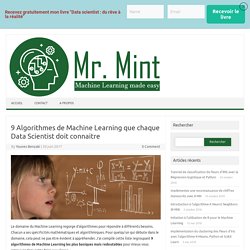
Chacun a ses spécificités mathématiques et algorithmiques. Pour quelqu’un qui débute dans le domaine, cela peut ne pas être évident à appréhender. J’ai compilé cette liste regroupant 9 algorithmes de Machine Learning les plus basiques mais redoutables pour mieux vous retrouver dans cette foire aux algos ! Note : J’ai préféré garder le nom anglais de ces algorithmes pour ne pas vous embrouiller avec des traductions “hasardeuses” 8 Algorithmes de Machine Learning expliqués en Language Humain – Datakeen.
Ce qu’on appelle Machine Learning ou Apprentissage automatique n’est autre que la rencontre des statistiques avec la puissance de calcul disponible aujourd’hui (mémoire, processeurs, cartes graphiques).
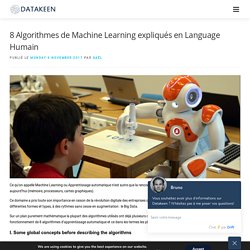
Ce domaine a pris toute son importance en raison de la révolution digitale des entreprises qui a conduit à la production de données massives de différentes formes et types, à des rythmes sans cesse en augmentation : le Big Data. 5. Dataset loading utilities — scikit-learn 0.20.3 documentation. The sklearn.datasets package embeds some small toy datasets as introduced in the Getting Started section.
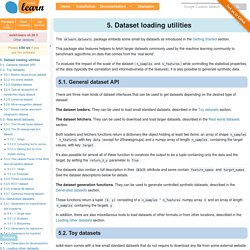
This package also features helpers to fetch larger datasets commonly used by the machine learning community to benchmark algorithms on data that comes from the ‘real world’. To evaluate the impact of the scale of the dataset (n_samples and n_features) while controlling the statistical properties of the data (typically the correlation and informativeness of the features), it is also possible to generate synthetic data. 5.1. General dataset API There are three main kinds of dataset interfaces that can be used to get datasets depending on the desired type of dataset. The dataset loaders. The dataset fetchers. Both loaders and fetchers functions return a dictionary-like object holding at least two items: an array of shape n_samples * n_features with key data (except for 20newsgroups) and a numpy array of length n_samples, containing the target values, with key target.
La France au firmament des frameworks de machine learning. Développé par l'INRIA, Scikit-learn s'impose parmi les librairies d'auto-apprentissage généralistes les plus prisées.
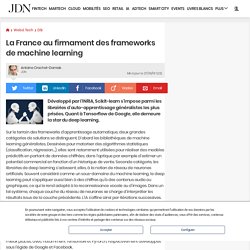
Quant à Tensorflow de Google, elle demeure la star du deep learning. Sur le terrain des frameworks d'apprentissage automatique, deux grandes catégories de solutions se distinguent. D'abord les bibliothèques de machine learning généralistes. Dessinées pour motoriser des algorithmes statistiques (classification, régression…), elles sont notamment utilisées pour réaliser des modèles prédictifs en partant de données chiffrées, dans l'optique par exemple d'estimer un potentiel commercial en fonction d'un historique de vente.
TPOT in Python. EpistasisLab/tpot: A Python Automated Machine Learning tool that optimizes machine learning pipelines using genetic programming. Welcome to STAT 508! Optimize Data for Predictive Analytics. Effective data preparation is critical for achieving optimal results.
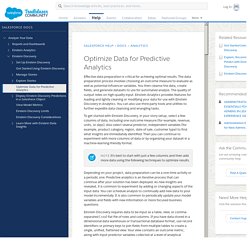
The data preparation process involves choosing an outcome measure to evaluate as well as potential influencer variables. You then cleanse the data, create fields, and generate datasets to use for automated analysis. The quality of output relies on high-quality input. Einstein Analytics provides features for loading and lightly cleaning or modifying your data for use with Einstein Discovery in Analytics. You can also use third-party tools and utilities to further expedite data cleansing and wrangling tasks. To get started with Einstein Discovery, in your story setup, select a few columns of data, including one outcome measure (for example, revenue, units, or days). Depending on your project, data preparation can be a one-time activity or a periodic one. Einstein Discovery requires data to be input as a table, view, or comma-separated (.csv) flat file of rows and columns.
Select an Outcome Metric Cleanse and Prepare Data. Is a Python dictionary an example of a hash table? Course-resources-ml-with-experts-budgets/1.0-full-model.ipynb at master · datacamp/course-resources-ml-with-experts-budgets. Multivariate Regression : Faire des prédictions avec plusieurs variables. Lors de mon précédent article, je vous ai montré comment implémenter la régression linéaire en utilisant une seule variable prédictive.
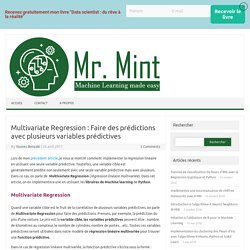
Toutefois, une variable cible est généralement prédite non seulement avec une seule variable prédictive mais avec plusieurs. Dans ce cas, on parle de Multivariate Regression (régression linéaire multivariée). How To Get Better Machine Learning Performance. 32 Tips, Tricks and Hacks That You Can Use To Make Better Predictions.
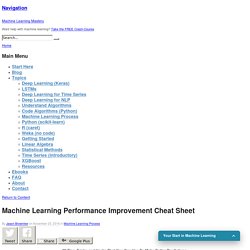
The most valuable part of machine learning is predictive modeling. This is the development of models that are trained on historical data and make predictions on new data. And the number one question when it comes to predictive modeling is: How can I get better results? This cheat sheet contains my best advice distilled from years of my own application and studying top machine learning practitioners and competition winners. With this guide, you will not only get unstuck and lift performance, you might even achieve world-class results on your prediction problems. Machine Learning : classer automatiquement vos données à l'import. Cet article est le premier d'une (longue ?)
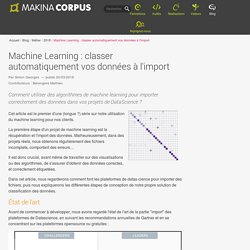
Série sur notre utilisation du machine learning pour nos clients. La première étape d'un projet de machine learning est la récupération et l'import des données. Malheureusement, dans des projets réels, nous obtenons régulièrement des fichiers incomplets, comportant des erreurs…